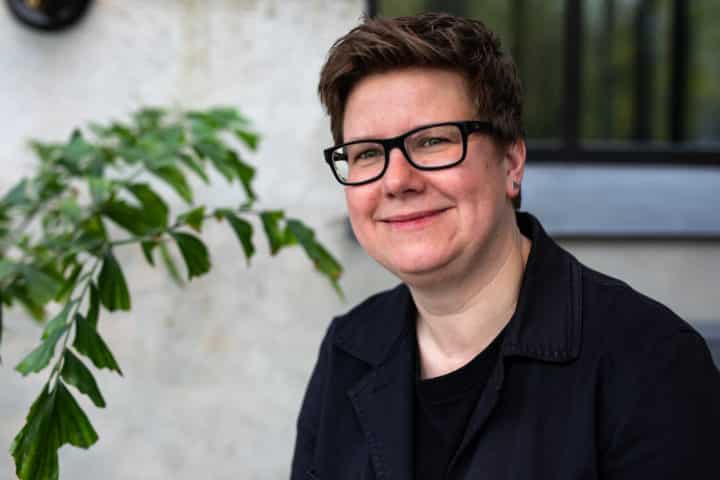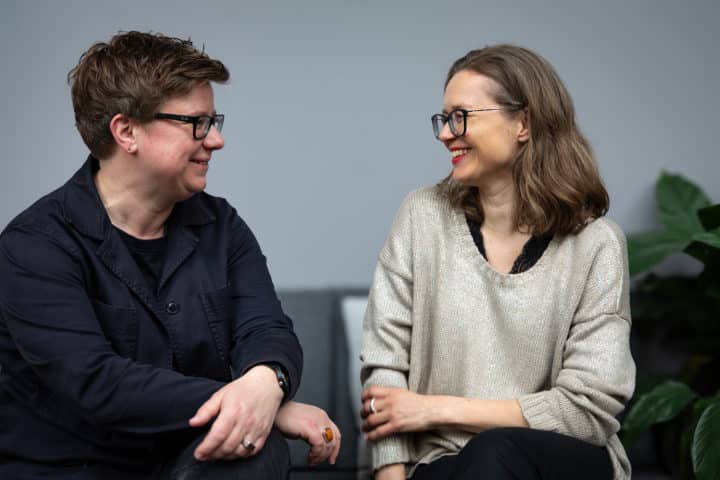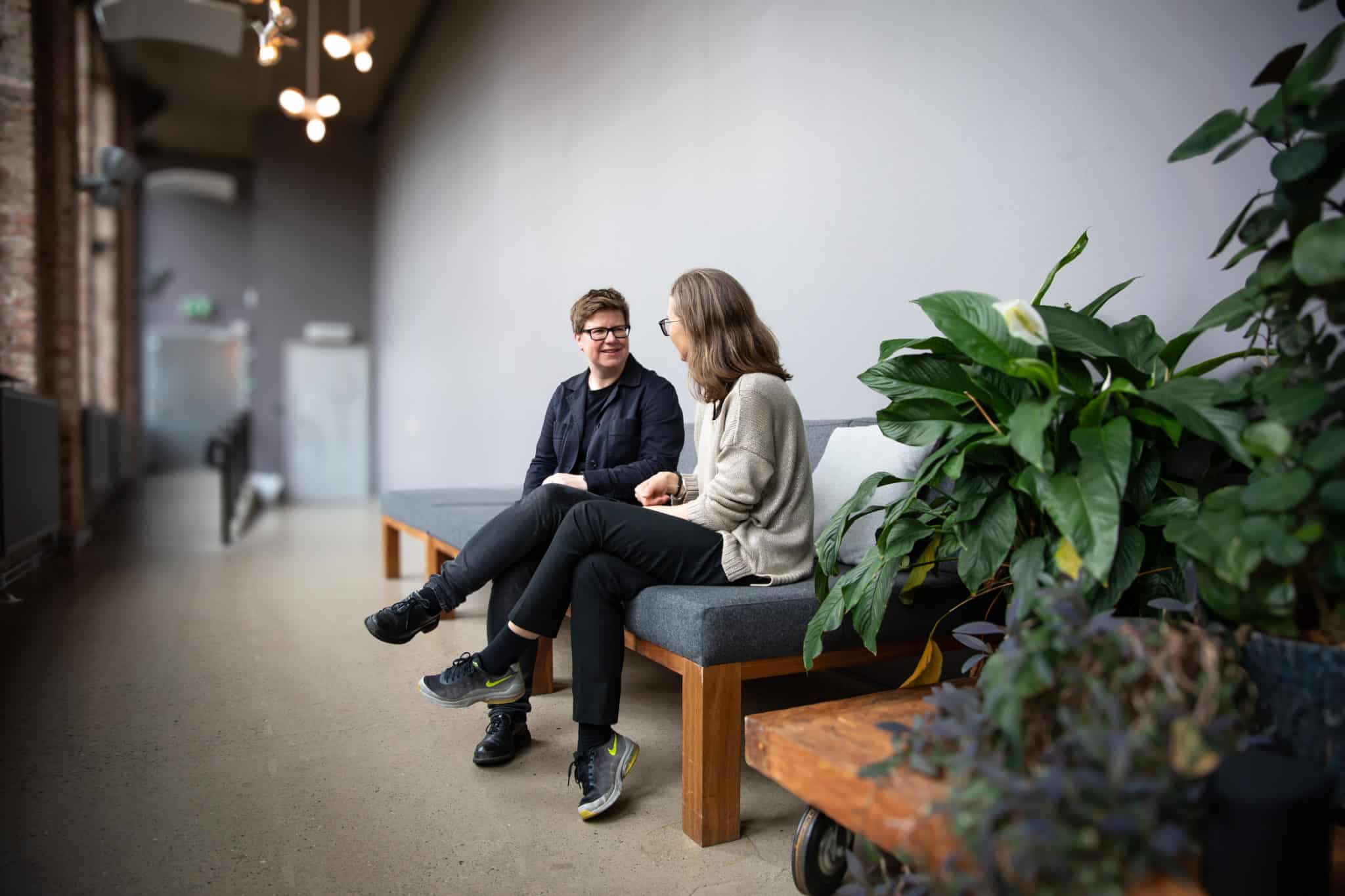Availability brings greater relevance to the dance field
Ther backgrounds and starting points are completely different. However, the former and new festival director at CODA share the passion for curating a dance program ahead of its time.
"I am very happy to pass the baton to Birgit, who has some different qualities that I hope will contribute to opening up even more."
After seven years as the artistic director of CODA Oslo International Dance Festival, Stine Nilsen has made her mark as a festival director with impressive international experience and a keen eye for relevant and diverse programming.

This year’s festival will be the last one she programmes, before Birgit Berndt assumes a fixed-term position as festival director and artistic leader.
Nilsen was not involved in the official recruitment process but was personally interested and engaged in who her successor would be. It was particularly important to her that the person shared the same core values.
– Inclusion is my most important cause, and I believe it’s vital and necessary for artists and audiences with different needs to have access to enjoy and participate in dance, says Nilsen.
The focus on audience engagement, accessibility, and the inclusion of artists from diverse backgrounds has been a recurring theme since the festival’s inception in 2002.
During Lise Nordal’s time as artistic director, hip-hop was included in the program. When Nilsen took over, she was among the first in Norway to include dancers with disabilities, featuring the renowned choreographer Claire Cunningham in 2017.
– Aesthetics, choice of format, and the artists involved are always open to change as we are a festival that strives to pick up on what is relevant here and now, Nilsen says, and continues: – I am very happy to pass the baton to Birgit, who has some different qualities that I hope will contribute to opening up even more.
Birgit Berndt has an extensive background in artistic and organizational leadership. In recent years, she has worked as the head of dance at Norrlandsoperan, but she has also worked as a dramaturge and in network building for many years. Talking about dance is her true passion, and Berndt believes that her strength lies in the analytical rather than the physical experience of dance.

– At Norrlandsoperaen, which is actually more of a production house than an opera house, we have programmed and produced a significant amount of contemporary dance and performance, both international and Nordic-based. One of the performances that CODA featured in 2021 had its premiere with us first, says Berndt, and continues: – I truly appreciate that as artistic director at CODA, I get to continue working with artists I have previously collaborated closely with.
No contradiction between inclusion and boundary-pushing
Stine and Birgit share a common goal of expansive programming and a wide-reaching impact. The festival embraces everything from hip-hop to contemporary dance with African roots. The festival’s broad thematic scope has occasionally attracted criticism towards CODA. In the fall of 2023, Scenekunst.no posed the question: What is the mandate, and where is the strong curatorial voice?
"The festival displays a broad understanding of dance, with various styles and expressions, but with the human body at the center of the artistry"
Berndt believes that the combination of breadth and more focused and niche elements is what makes it most interesting.
-It is, of course, important to contextualize and communicate the relevance and how these expressions relate to each other – to create a connection between artistry and context for the audience. In my opinion, CODA has made it their trademark to challenge the boundaries of what dance can be, she says enthusiastically, and elaborates: – The festival shows a broad understanding of dance, with various styles and expressions, but with the body at the center of the artistry.
Berndt mentions that she intends to carry forward Stine’s core values; she wants to see a stronger emphasis on accessibility and believes it gives the dance field greater relevance in society.
-There is no contradiction between inclusion and boundary-pushing. Many believe that pushing boundaries is about narrowing and tailoring to the few. I see this as a misunderstanding. I would rather say that they are two sides of the same coin.
Nilsen agrees with her colleague and believes that it is precisely the inclusion of different bodies and experiences that makes the festival boundary-pushing.
-If we really were a broad festival, we would include styles like salsa on the program. Salsa is a dance that more people could relate to, simply because it is a social dance. The same goes for waltz and traditional ballet performances. But we have chosen to place the festival in contemporary art, because we see this as the most relevant expression, says Nilsen.
The former festival director compares contemporary dance to the crow: it steals from various styles and transforms these expressions into something new.
-The human body often takes center stage in contemporary dance, and the physical expression is central. The dancer asks: How can I convey what I am passionate about, from my body to the audience?
Art in Public Spaces
Nilsen has led the curation of this year’s CODA program. She notes that this year, as in the past, she has facilitated several productions outside of traditional performance spaces.
"Dance art in public spaces communicates with the audience in a different way"
-We will be collaborating with MUNCH and their live program, as well as Unge Kunstneres Samfund, which clearly indicates that we are considering dance and movement in relation to different audience groups. This year’s festival will also feature a unique sauna experience, says Nilsen.
In this regard, CODA demonstrates that they are in tune with current trends. Recently, it was revealed that a record number of dance artists have applied for funding to create art in public spaces. Nilsen attributes this trend to two main reasons:
-Dance art in public spaces communicates with the audience in a different way. Additionally, there is a lack of resources for performances intended for larger stages, says Nilsen, and elaborates: – Compared to ten years ago, more dance artists are creating their own works. All but one of the stages in Oslo are curated. This power imbalance leads many dance artists to create outdoor art partly because they seek a different type of presentation, and partly due to the freedom that comes from not being dependent on curation and selection.
According to the two festival directors, today’s generation is developing their own strategies for executing their artistic visions. This also leads to the creation of new performing arts – a direct response to the times we live in.
-This makes it even more urgent to reclaim public space as a space for both artistic judgment and community opportunity. It’s a question of democracy: Who has access to culture, and where? says Berndt, and adds: – When we speak with the dance artists themselves, many express a need to do things differently. They want to reach audiences who do not frequent traditional venues and utilize new and more sustainable working processes.
Berndt further explains that artists have a natural need for human encounters and to handle societal resources carefully in a time of numerous conflicts and global environmental crises.
-The green transition is clearly a hot topic in the dance field. Dance artists need more time to build relationships and to create for and in the places we inhabit daily. This approach is both more sensitive to human interactions and to societal resources.

Dance has the potential to be more than itself
The outgoing and incoming festival directors both believe that CODA’s most important mandate is to contribute to the development of new artistic practices and provide space for artists to experiment with new projects.
"As a festival, we send out an incredibly important message by not exclusively programming and curating for a guaranteed outcome."
– Some festivals focus exclusively on new work, while others are more selective in their curation. For us, it has always been important to invest in some premieres, says Nilsen.
But this approach comes with an element of risk.
– Programming premieres means taking a chance on an artist’s idea. It doesn’t always turn out as the artist envisioned, and that’s just the way it is, says Nilsen with a smile. – As a festival, we send out an incredibly important message by not exclusively programming and curating for a guaranteed outcome. Ideally, all performing arts organizations should invest resources in new productions. Artists, festivals, and organizers are part of the same ecosystem, and it’s about sharing resources. That’s the only way new work can be produced, adds Birgit.
That said, it’s not just the number of premieres or the latest trends that define a festival’s relevance. Both Berndt and Nilsen believe that good curation involves constantly being on the lookout; seeking out artists across geographical boundaries and programming work with historical and sustainable perspectives in dance.
– I believe that as a curator, you should be ahead of your time and introduce the audience to the next hot thing, says Nilsen, and continues: – But the masterstrike also often lies in finding a piece that still says something important even after two or three or five years. Not only do we introduce the audience to an important work, but we also show the artist that their work is valued and still relevant.
Berndt believes that the festival’s greatest strength is its ability to bring together a wide range of artistic practices. Since the festival takes place over a short but intense period, it allows for a much more specific focus and the opportunity to place dance in relevant contexts.
– Dance has incredible potential to be more than just choreographed steps. The art form is alive and poetic, but it should also express critical reflection in society. Being inclusive doesn’t mean we can’t address uncomfortable questions.
– You are not afraid of discomfort?
– No, friction is as important as harmony – and even entertainment, when it comes to dance. I don’t think we should be afraid that the audience might experience discomfort, as long as we are clear in our communication and provide the work with a clear context. Discomfort can be encompassing and provide meaningful dance experiences, says Berndt, and continues:
"Dance has the advantage of being more than just an intellectual experience; it is something felt in the body. Emotions are at the core, encompassing both pleasure and discomfort, and the ideal is if we can explore the full range"



